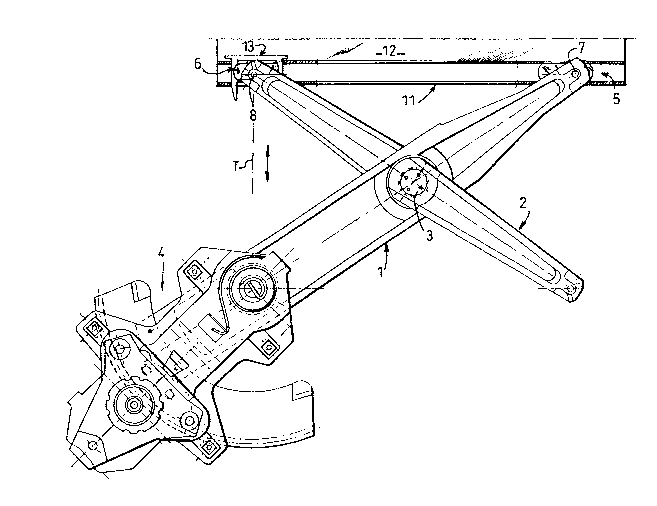Une partie des informations de ce site Web a été fournie par des sources externes. Le gouvernement du Canada n'assume aucune responsabilité concernant la précision, l'actualité ou la fiabilité des informations fournies par les sources externes. Les utilisateurs qui désirent employer cette information devraient consulter directement la source des informations. Le contenu fourni par les sources externes n'est pas assujetti aux exigences sur les langues officielles, la protection des renseignements personnels et l'accessibilité.
L'apparition de différences dans le texte et l'image des Revendications et de l'Abrégé dépend du moment auquel le document est publié. Les textes des Revendications et de l'Abrégé sont affichés :
| (12) Demande de brevet: | (11) CA 2094216 |
|---|---|
| (54) Titre français: | SUPPORT DES GLACES D'UNE VOITURE; DISPOSITIF D'OUVERTURE/FERMETURE DES GLACES COMPORTANT CE SUPPORT |
| (54) Titre anglais: | WINDOW SUPPORT DEVICE IN A MOTOR VEHICLE WINDOW WINDER AND WINDOW LIFTING MEANS INCLUDING THIS DEVICE |
| Statut: | Réputée abandonnée et au-delà du délai pour le rétablissement - en attente de la réponse à l’avis de communication rejetée |
| (51) Classification internationale des brevets (CIB): |
|
|---|---|
| (72) Inventeurs : |
|
| (73) Titulaires : |
|
| (71) Demandeurs : |
|
| (74) Agent: | PASCAL & ASSOCIATES |
| (74) Co-agent: | |
| (45) Délivré: | |
| (22) Date de dépôt: | 1993-04-16 |
| (41) Mise à la disponibilité du public: | 1993-10-23 |
| Licence disponible: | S.O. |
| Cédé au domaine public: | S.O. |
| (25) Langue des documents déposés: | Anglais |
| Traité de coopération en matière de brevets (PCT): | Non |
|---|
| (30) Données de priorité de la demande: | ||||||
|---|---|---|---|---|---|---|
|
ABSTRACT
This device comprises arms (1, 2) arranged in X
configuration, a shaped rail (11) inside which there are
mounted rollers (5, 6) to which are articulated the ends
of the arms (1, 2), one (6) of the rollers being provided
with means for blocking in the rail whilst the other
roller (5) can slide in the latter; the means for block-
ing the said roller (6) comprise an elastic clamp (13)
with two branches (14) shaped so as to be able to cap the
opposite ends of the roller, and through-holes for these
branches are made in the walls of the rail so that the
said branches pass through the rail from one side to the
other, clamping the roller between them. This clamp is
easy to install and can be fitted to existing rollers,
which avoids the use of special components and therefore
decreases the manufacturing costs of the device.
Note : Les revendications sont présentées dans la langue officielle dans laquelle elles ont été soumises.
Note : Les descriptions sont présentées dans la langue officielle dans laquelle elles ont été soumises.

2024-08-01 : Dans le cadre de la transition vers les Brevets de nouvelle génération (BNG), la base de données sur les brevets canadiens (BDBC) contient désormais un Historique d'événement plus détaillé, qui reproduit le Journal des événements de notre nouvelle solution interne.
Veuillez noter que les événements débutant par « Inactive : » se réfèrent à des événements qui ne sont plus utilisés dans notre nouvelle solution interne.
Pour une meilleure compréhension de l'état de la demande ou brevet qui figure sur cette page, la rubrique Mise en garde , et les descriptions de Brevet , Historique d'événement , Taxes périodiques et Historique des paiements devraient être consultées.
| Description | Date |
|---|---|
| Inactive : CIB de MCD | 2006-03-11 |
| Le délai pour l'annulation est expiré | 1995-10-16 |
| Demande non rétablie avant l'échéance | 1995-10-16 |
| Réputée abandonnée - omission de répondre à un avis sur les taxes pour le maintien en état | 1995-04-17 |
| Inactive : Demande ad hoc documentée | 1995-04-17 |
| Demande publiée (accessible au public) | 1993-10-23 |
| Date d'abandonnement | Raison | Date de rétablissement |
|---|---|---|
| 1995-04-17 |
Les titulaires actuels et antérieures au dossier sont affichés en ordre alphabétique.
| Titulaires actuels au dossier |
|---|
| ROCKWELL AUTOMOTIVE BODY SYSTEMS - FRANCE |
| Titulaires antérieures au dossier |
|---|
| PATRICE CARDINE |